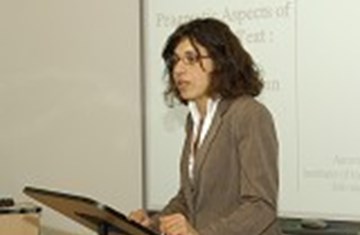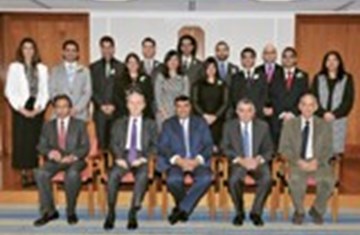Qur’anic Studies Lecture on Shi‘i Tafsir Classification and Sultan‘alishah’s Bayan al-Sa‘ada
In his presentation, delivered in May 2010, Dr Cancian explained that hermeneutics play a crucial role in defining what a religion is and how it should be professed and practised, which is demonstrated by the fact that virtually every religion has developed its own vast and articulate exegetical tradition. With regard to the relationship between authority and exegesis in Islam, he mentioned that the majority - if not all - of the most celebrated classical scholars played a role in Islam’s tradition of exegesis. He then summarised the history and types of tafasir.
Dr Cancian looked in more detail at the tafsir entitled Bayan al-Sa‘ada fi Maqamat al-‘Ibada, which he considers as marking an epoch in the history of modern Shi‘i Sufism, and deserving of more attention. Its author, Sultan ‘Ali Shah (1835-1909), of the Gonabadi branch of Ni‘matullahi Sufism, was a towering intellectual of his age in many respects, yet his writings are little known in Western academia and outside of the Persian speaking world. His tafsir is a comprehensive enterprise, as he was a mystic, philosopher and authorised mujtahid. Throughout, it is punctuated with juridical responses to challenging issues of his time, in-depth discussions of debated theological issues, and articulate scrutiny of technical themes of Sufism.
Dr Cancian noted that the wide circulation of the Bayan al-Sa‘ada among the followers of Shi‘i esotericism in Iran survived the political ups and downs of the 20th century. Despite the unsympathetic official attitude towards Sufi orders, its influence has not vanished. Sultan ‘Ali Shah, through his tafsir, has contributed to the perseverance and development of an entire exegetical tradition, whose roots are in classical medieval Sufism, Safavid hikmat-i ilahi, and the rich corpus of Shi’i riwayat.
In concluding his talk, Dr Cancian stated that the extent of Bayan al-Sa‘ada’s influence can only be appreciated against a systematic analysis of its textual consistency and its sources (primarily Sulami, Maybudi, the Mathnawi of Rumi, and Fayd Kashani). It is only through this analysis that a reliable portrait of the work’s key role as a hermeneutic bridge between the pre-modern and modern stages of Shi‘i mystical exegesis might be disclosed. Such a portrait would be an invaluable work that would open the way for new and promising lines in the study of mystical exegesis, and tafsir in general.
Related Pages on the IIS Website






